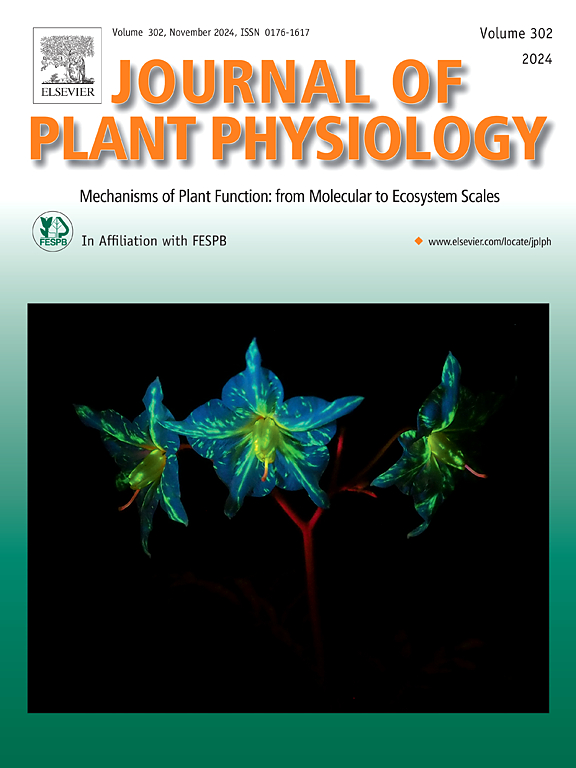●Dynamic changes of rice sheath non-structural carbohydrates and source-sink balance under elevated atmospheric CO2 concentration and temperature stresses
IF 4.1
3区 生物学
Q1 PLANT SCIENCES
引用次数: 0
Abstract
Rising CO2 levels and temperatures significantly affect rice yield and quality by altering key physiological processes. As vital carbon reserves, non-structural carbohydrates (NSC) maintain the source-sink balance, directly influencing grain filling and food security. This study simulated high CO2 and temperature conditions using open-top chambers with four treatment groups: control (ACT, ambient CO2 at 415 ppm and temperature), elevated CO2 (EC, 600 ppm CO2), elevated temperature (ET, ambient +2°C), and combined CO2 and temperature elevation (ECT, 600 ppm CO2 +2°C). NSC concentrations, along with key physiological indexes such as leaf nitrogen and antioxidant enzyme activity, and gene expression, was measured to assess climate impacts on japonica rice variety “Nanjing 9108” physiology and source-sink balance. This study found that EC enhanced NSC concentrations, increasing soluble sugars and starch by 6.33% and 9.86% at heading, raising stem sheath NSC by 9.30%. Conversely, ET reduced sugars and starch by 16.67% and 6.24%, leading to a 7.75% NSC decrease. Under ECT, NSC levels dropped by 1.07%. Nitrogen concentrations in leaves, stem sheaths, and panicles declined under both EC and ET, EC reduced leaf nitrogen by 16.26%, while ET lowered nitrogen in stem sheaths and panicles by 17.29% and 16.53%. EC upregulated OsSUT1 and OsSUT2 gene expression by 69.55% and 131.85%, boosting carbon transport, whereas ET suppressed those genes, reducing grain carbon supply. Overall, elevated CO2 improves NSC accumulation and transport, enhancing yield potential, while elevated temperature hinders these processes. Managing NSC and nitrogen dynamics is crucial to ensure stable rice yields under climate change.
●大气CO2浓度升高和温度胁迫下水稻鞘非结构性碳水化合物及源库平衡的动态变化
升高的CO2水平和温度通过改变水稻的关键生理过程,显著影响水稻的产量和品质。非结构性碳水化合物(non-structural carbohydrate, NSC)作为重要的碳储备,维持着源库平衡,直接影响着粮食灌浆和粮食安全。本研究使用开顶箱模拟了高二氧化碳和高温条件,有四个处理组:对照组(ACT,环境二氧化碳在415 ppm和温度下),升高的二氧化碳(EC, 600 ppm CO2),升高的温度(ET,环境+2°C),以及二氧化碳和温度升高的组合(ECT, 600 ppm CO2 +2°C)。通过测定NSC浓度、叶片氮素、抗氧化酶活性及基因表达等关键生理指标,探讨气候对“南京9108”粳稻生理及源库平衡的影响。本研究发现,EC提高了NSC浓度,抽穗期可溶性糖和淀粉分别提高了6.33%和9.86%,茎鞘NSC提高了9.30%。相反,ET减少了16.67%和6.24%的糖和淀粉,导致NSC降低了7.75%。在ECT治疗下,NSC水平下降了1.07%。蒸散发和蒸散发均降低了叶片、茎鞘和穗部的氮含量,蒸散发使叶片氮含量降低了16.26%,而蒸散发使茎鞘和穗部的氮含量分别降低了17.29%和16.53%。EC上调OsSUT1和OsSUT2基因表达69.55%和131.85%,促进碳转运,ET抑制OsSUT1和OsSUT2基因表达,减少谷物碳供应。总的来说,升高的CO2促进了NSC的积累和运输,提高了产量潜力,而升高的温度则阻碍了这些过程。在气候变化条件下,控制NSC和氮素动态是确保水稻稳定产量的关键。
本文章由计算机程序翻译,如有差异,请以英文原文为准。
求助全文
约1分钟内获得全文
求助全文
来源期刊

Journal of plant physiology
生物-植物科学
CiteScore
7.20
自引率
4.70%
发文量
196
审稿时长
32 days
期刊介绍:
The Journal of Plant Physiology is a broad-spectrum journal that welcomes high-quality submissions in all major areas of plant physiology, including plant biochemistry, functional biotechnology, computational and synthetic plant biology, growth and development, photosynthesis and respiration, transport and translocation, plant-microbe interactions, biotic and abiotic stress. Studies are welcome at all levels of integration ranging from molecules and cells to organisms and their environments and are expected to use state-of-the-art methodologies. Pure gene expression studies are not within the focus of our journal. To be considered for publication, papers must significantly contribute to the mechanistic understanding of physiological processes, and not be merely descriptive, or confirmatory of previous results. We encourage the submission of papers that explore the physiology of non-model as well as accepted model species and those that bridge basic and applied research. For instance, studies on agricultural plants that show new physiological mechanisms to improve agricultural efficiency are welcome. Studies performed under uncontrolled situations (e.g. field conditions) not providing mechanistic insight will not be considered for publication.
The Journal of Plant Physiology publishes several types of articles: Original Research Articles, Reviews, Perspectives Articles, and Short Communications. Reviews and Perspectives will be solicited by the Editors; unsolicited reviews are also welcome but only from authors with a strong track record in the field of the review. Original research papers comprise the majority of published contributions.
 求助内容:
求助内容: 应助结果提醒方式:
应助结果提醒方式:


